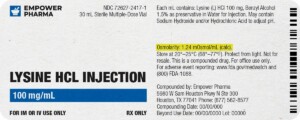Tirzepatide/niacinamide injection is generally well tolerated. The most common side effects are gastrointestinal and tend to occur early in treatment or during dose increases. Nausea, decreased appetite, and indigestion are frequently reported. Diarrhea is also common, and a smaller number of individuals may experience vomiting, particularly during dose escalation. These symptoms are usually temporary and tend to improve over time. Gradual dose titration helps minimize discomfort. Constipation, bloating, and a feeling of fullness may also occur, sometimes accompanied by belching or abdominal discomfort.
Outside the gastrointestinal system, other side effects are less common. Mild injection site reactions, such as redness or itching, can occur but typically resolve without intervention. Allergic reactions are rare; however, symptoms like widespread rash, facial swelling, or difficulty breathing require immediate medical attention and discontinuation of the medication.
Tirzepatide does not typically cause low blood sugar when used alone, as it only stimulates insulin release when blood glucose is elevated. However, when combined with other medications that lower blood sugar, such as insulin or sulfonylureas, there is a risk of hypoglycemia. In such cases, patients may need to adjust the doses of those medications. Signs of low blood sugar include shakiness, sweating, dizziness, and confusion, and should be addressed promptly.
Rare but serious side effects may include pancreatitis and gallbladder problems. Patients should seek medical attention if they experience severe or persistent abdominal pain, especially if it radiates to the back or is accompanied by vomiting. Rapid weight loss may increase the risk of gallstones or gallbladder inflammation. Drinking adequate fluids and maintaining a steady rate of weight loss may help reduce this risk. Any new upper abdominal pain or digestive symptoms should be evaluated by a healthcare provider.
In some individuals with long-standing diabetes, rapid improvements in blood sugar may temporarily worsen diabetic eye disease. Any vision changes should be promptly reported and evaluated.
Although thyroid tumors have been observed in animals given high doses of tirzepatide, the relevance to humans remains unclear. As a precaution, patients should inform their healthcare provider if they notice a lump in the neck, changes in voice, or difficulty swallowing.




 Semaglutide / Cyanocobalamin Injection
Semaglutide / Cyanocobalamin Injection Tirzepatide ODT
Tirzepatide ODT Sermorelin Acetate Injection
Sermorelin Acetate Injection Bella Capsules
Bella Capsules Lipo-C Injection
Lipo-C Injection Lipo-B Injection
Lipo-B Injection Phentermine HCl Capsules
Phentermine HCl Capsules Lipo Injection
Lipo Injection Sermorelin Acetate ODT
Sermorelin Acetate ODT Ondansetron ODT
Ondansetron ODT